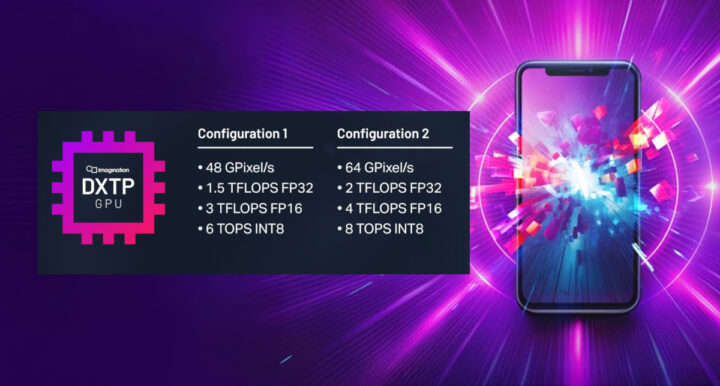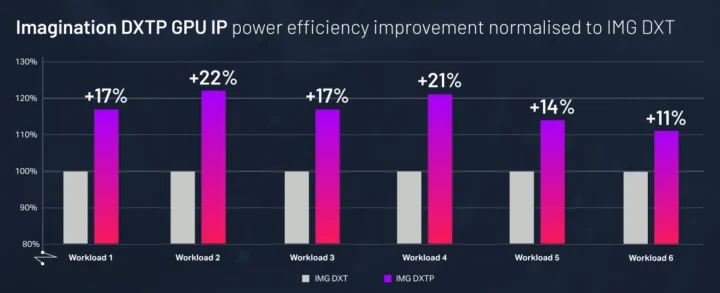Imagination has announced the DXTP GPU for mobile and power-constrained devices with up to 20% greater power efficiency than its predecessor, the D-Series DXT GPU for longer battery life for AI applications or complex games.
The company says the GPU is suitable for gaming, user interfaces, graphics-rich applications, computer vision, generative AI, and other AI applications designed to run on smartphones, tablets, laptops, desktops, or non-safety automotive products.
Imagination DXTP highlights:
- Two off-the-shelf configurations:
- DXTP-48-1536
- 48 GPixel/s
- 1.5 TFLOPS FP32 (1536 FLOPs/Clock)
- 3 TFLOPS FP16
- 6 TOPS INT8
- 48 ppc Bilinear 3D Textured
- Up to 96 ppc 2D Dual Rate Mode
- DXTP-64-2048
- 64 GPixel/s
- 2 TFLOPS FP32 (2048 FLOPs/Clock)
- 4 TFLOPS FP16
- 8 TOPS INT8
- 64 ppc Bilinear 3D Textured
- Up to 128 ppc 2D Dual Rate Mode
- DXTP-48-1536
- Bus Interface – AXI, ACE-Lite
- Compression
- PVRIC5 Lossless and Lossy Framebuffer Compression
- ETC and ASTC LDR and HDR Support
- Microarchitecture improvement – DXTP delivers higher sustained performance, faster compute scheduling, and 50% more geometry throughput compared to the DXT, as well as higher energy efficiency than DXT thanks to microarchitectural improvements that boost FPS/W by up to 20% on “popular graphics workloads”.
- New features – Hardware-based virtualization for fully secure GPU multitasking, asynchronous compute for the simultaneous processing of graphics and compute workloads and
a frame buffer compression solution that allows for bandwidth reduction without compromising display quality. - Compute Software – Optimized OpenCL compute libraries (imgNN, imgFFT, imgBLAS) enable up to 4x better performance for AI applications compared to open-source offerings. Reference kits for oneAPI and TensorGraph are also provided, as well as optimized LiteRT support for high-performance AI on Android.
- Supported OS and API – Linux and Android with support for OpenGL ES 3.2, OpenCL 3.0 FP, and Vulkan 1.4. OpenGL 4.6 is supported via Zink
Imagination shared some power-efficiency numbers comparing DXTP and DXT GPUs, but it’s not super useful as they decided to keep the workloads used confidential… likely a lawyer’s idea…
I suspect it’s a combination of games and AI-powered applications… At least the company is already working on chips based on the DXTP GPU:
Zelos is integrating the advanced, power-efficient compute ofImagination DXTP into our upcoming chip. Imagination’s GPUs combine the performance of ultra-parallel processing with the flexibility that comes from a highly programmable architecture, making them the ideal platform for accelerating our AI models.
Here, Zelos is not the watchmaking company, but Zelos Technology which specializes in autonomous vehicles. A few more details may be found on the product page, and there’s also a webinar on March 5 if you want to learn more.

Jean-Luc started CNX Software in 2010 as a part-time endeavor, before quitting his job as a software engineering manager, and starting to write daily news, and reviews full time later in 2011.
Support CNX Software! Donate via cryptocurrencies, become a Patron on Patreon, or purchase goods on Amazon or Aliexpress






